We Will Miss You, Maurice Sendak
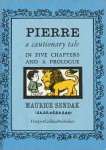 May 8, 2012, the children’s book world lost an honored artist/author/illustrator, Maurice Sendak. Most people remember his book Where the Wild Things Are, but Sendak was by no means a one-hit wonder. He wrote and/or illustrated dozens of children’s books, so today, I’m mentioning a few of my favorites by the master from his 1962 collection, “The Nutshell Library”.
May 8, 2012, the children’s book world lost an honored artist/author/illustrator, Maurice Sendak. Most people remember his book Where the Wild Things Are, but Sendak was by no means a one-hit wonder. He wrote and/or illustrated dozens of children’s books, so today, I’m mentioning a few of my favorites by the master from his 1962 collection, “The Nutshell Library”.
Pierre: a cautionary tale in five chapters and a prologue is a favorite from my childhood. Pierre is so apathetic that he answers “I don’t care,” in any situation, even when a lion asks, “Then I’ll eat you, if I may.” Don’t worry, Pierre is fine when he’s shaken out of the lion by the doctor, and his close call with death has made him realize that he does care after all.
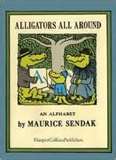 Alligators All Around is Sendak’s clever, alliterative alphabet book. It is short and snappy enough to keep the interest of the littlest ones, but the humorous art is sly enough for older kids as well:
Alligators All Around is Sendak’s clever, alliterative alphabet book. It is short and snappy enough to keep the interest of the littlest ones, but the humorous art is sly enough for older kids as well:
“A: alligators all around
B: bursting balloons
C: catching colds
D: doing dishes”
It’s a great writing prompt for a whole class or small group activity, writing two word alliterative phrases for each letter of the alphabet, choosing an A animal as the character to tie all the letters together.
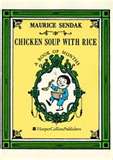 “Whoopy once
“Whoopy once
whoopy twice
whoopy chicken soup
with rice.”
I adore Chicken Soup with Rice: a book of months. I visited a first grade classroom where the teacher had a poster for each month with the verse by Sendak for children to illustrate. Every month has the repetition of (something) once, (something) twice, (something) chicken soup with rice, so even emerging readers can chime in with confidence.
The “Nutshell Library” books were set to music by Carole King. You can find the songs on her cd “Really Rosie”, and you can find the animated television special made in 1975 on VHS if you roll old school. I love how kids instantly spot the similarities of Pierre and the boy on the cover of Chicken Soup with Rice to Max from Where the Wild Things Are. Share some Sendak books with your kids and talk about the similarities and differences in the art and in the plots. Play the music from “Really Rosie” and let your students sing the “Nutshell Library” books so your students can be, to paraphrase Alligators All Around, “S: singing Sendak!”
Read MoreRah, Rah, Radishes!
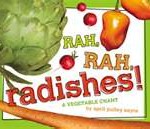 Three cheers for April Pulley Sayre and Rah, Rah, Radishes! A Vegetable Chant! How do you make healthy eating fun? With Sayre’s vibrant photos of vegetables taken at her local farmer’s market paired with her contagious rhymes:
Three cheers for April Pulley Sayre and Rah, Rah, Radishes! A Vegetable Chant! How do you make healthy eating fun? With Sayre’s vibrant photos of vegetables taken at her local farmer’s market paired with her contagious rhymes:
“Oh boy, bok choy!
Brussels sprout.
Broccoli. Cauliflower.
Shout it out!”
Start your lesson by asking students, “What do you think kohlrabi is? How about fennel? Rutabaga?” Read Rah, Rah, Radishes! and see if your kids can discover what those uncommon words mean. Encourage kids to chime in as you reread (“Go, green bean!”) Play “Cross the Line”: all the kids stand one one side of the classroom and imagine an invisible line down the middle of the room – or put down tape if your maintenance team won’t go nuts. Say “Cross the line if you’ve tried broccoli,” asparagus, the vegetables listed in the book. Have kids brainstorm vegetables that didn’t make the book. Is a tomato a vegetable? Find out in the back of Sayre’s book! If you have time and funds, bring in some vegetables for kids to try! Take photos of the vegetables and have kids use those Logic Smarts to sort the photos – by color, by part of plant (root, stem, leaf, or fruit), by which they liked and which they didn’t. With all the gorgeous colors of fresh produce, you can make a “color wheel” using vegetables – challenge kids to eat a rainbow! Rah, Rah, Radishes, hooray healthy eating, and super job, Ms. Sayre!
For more information, visit aprilsayre.com.
Read MoreThe Piggy in the Puddle
 “See the piggy,
“See the piggy,
see the puddle,
see the muddy little puddle.
See the piggy in the middle
of the muddy little puddle.”
This classic tongue-twisting pig tale, The Piggy in the Puddle, by Charlotte Pomerantz and James Marshall is almost 40 years old, and it is still pure fun to read aloud. The muddy little piggy in the middle of the puddle is told by her family that she must come out of the “squishy-squashy”, “mooshy-squooshy”, “oofy-poofy” mud. Her reply? “Nope!” So what’s a pig to do but join her? Soon the whole family, “big and little”, are “in the very merry middle.”
After you’ve read this book through once just for fun, see if your listeners can keep a simple beat for you as you read it aloud again – just make sure the beat isn’t too fast or you’ll end up tongue-tied! You can use this book with preschoolers through third graders to talk about sounds. Little ones can focus on beginning sounds of P and M, older ones can sort words with short i or short u sounds, or look for “double letters”. For a super-simple craft (because that’s how I roll), I die-cut pigs for kids to glue to construction paper, and then, using just one fingertip (so we wouldn’t end up muddy like the pigs) we dabbed brown paint on our paper to make mud puddles and muddy piggies. Good, clean(ish) fun!
For more information, visit charlottepomerantz.com.
Read MoreThe Ballad of Valentine
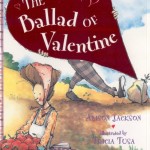 “Oh my darling, oh my darling, oh my darling Valentine,
“Oh my darling, oh my darling, oh my darling Valentine,
I have written forty letters, but you’ve never read a line.”
Alison Jackson and Tricia Tusa have me singing this Valentine’s Day. In their book, The Ballad of Valentine, a narrator tries most every way he can to let his true love know how he feels about her: he trains a homing pigeon and attaches a note with twine, taps a note in Morse code “asking you to please be mine”, rents out a mail car on the westward railroad line, but nothing works. Thank goodness his true love isn’t a gal who just waits around, for although his efforts fail, she’s been busy baking a cake and she asks him to be her Valentine.
After you croon this book along with your little darlings, have them take a look at all the “ine” words. We call our lists of words with the same endings “word families”, so make an “ine” word family with your little ones. You can go through the book and see which ones Alison Jackson used, and then brainstorm more to add to the list. Sitting in a circle, you can pass around a clementine to each student, or roll a ball of twine, and have kids come up with an “ine” word. Practicing rhymes with your Valentines – it’s divine!
For more information, visit alison-jackson.com.
Read More






